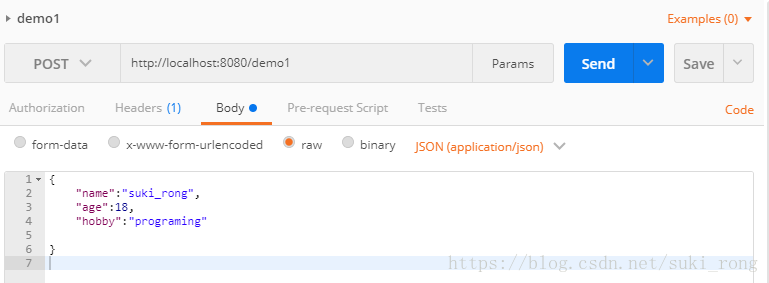SpringBoot 前后端数据交互的几种常用方式
⏰ SpringBoot 前后端数据交互的几种常用方式
1. 用于获取参数的几种常用注解
@PathVariable: 获取 URL 后所携带的参数,即 url/{param} 这种形式。也就是一般我们使用的 GET,DELETE,PUT方法会使用到的
@RequestParam:一般我们使用该注解来获取多个参数,在()内写入需要获取参数的参数名即可,一般在PUT,POST中比较常用。比如 @RequestParam("name") 表示接收前端传过来的参数 name
@RequestBody:该注解和 @RequestParam 殊途同归,我们使用该注解将所有参数转换,在代码部分在一个个取出来。比如 @RequestBody User user 表示利用 User 类接受前端传过来的参数。
还有 @RequestHeader 来获取头信息里的值,@CookieValue来获取 Cookie 值等等
⭐ 现在大多数互联网项目都是采用前后端分离的方式开发,前端人员负责页面展示和数据获取,后端负责业务逻辑处理和接口封装。前后端之间的交互通常使用 JSON 数据,一般来说后端使用 @RequestBody 注解来获取前端传过来的 JSON 数据。
2. 请求参数类型
前端传送过来的参数无非以下 3 种类型:
- 请求路径参数:比如说
url/{id}或者url?name=123这种形式 - Body 参数
- 请求头参数以及 Cookie
3. 针对不同的请求参数类型采用不同的注解
① 请求路径参数
Ⅰ get 请求,url 路径传参 url?name=123
get 请求一般通过 url 传参,如:http://localhost:8080/hello?name=123
后端要获取到 url 携带的参数 name,可以使用 @RequestParam 注解:
@RestController
public class HelloController {
@GetMapping(value="/hello")
public String sayHello(@RequestParam("name") String name){
return "name:"+name;
}
}
Ⅱ get 请求,url 路径参数 url/{id}
如:http://localhost:8080/hello/1/jack
后端可以使用 @PathVariable 接收路径参数 1 和 jack
@RestController
public class HelloController {
@GetMapping(value="/hello/{id}/{name}")
public String sayHello(@PathVariable("id") Integer id,
@PathVariable("name") String name){
return "id:"+id+" name:"+name;
}
}
② Body 参数
一般来说,前端发送过来的数据采用的都是 JSON 格式,后端可以使用 @RequestBody 进行接收。
比如说,前端发送过来的数据如下:

假如说有个 Person 类的属性也是 name、age、hobby,那么就可以使用 Person 类接收该数据:
@PostMapping(path = "/demo1")
public void demo1(@RequestBody Person person) {
System.out.println(person.getName());
System.out.println(person.getAge());
}
当然,也可以使用 Map 进行接收:
@PostMapping(path = "/demo1")
public void demo1(@RequestBody Map<String, String> map) {
System.out.println(map.get("name"));
}
🚨 注意:使用 @RequestBody 注解接收参数的时候,从名称上来看也就是说要读取的数据在请求体里,前端必须指定请求 JSON 数据的Content-Type 必须要为 application/json,所以要发 POST 请求,因为 Ajax 使用的POST,并且发送的是 JSON 对象。比如 👇
<head>
<title>Title</title>
<script type = "text/javascript">
$(function(){
$("#testJson").click(function(){
$.ajax({
type: "post",
url: "/demo1",
contentType: "application/json; charset= utf-8",
data: '{"name":"小黑", "age":20, "hobby":"basketball"}',
dataType: "json",
success:function(data){
alert(data);
// alert(data.age);
}
});
});
});
</script>
</head>
<body>
<button id = "testJson">测试 ajax 请求 json 和响应 json</button>
</body>
💡 对于 Vue 来说,可以直接简单的使用
axios来完成 JSON 数据的发送
③ 请求头参数以及 Cookie
后端可以通过 HttpServletRequest 获取请求头的内容,如:

@GetMapping("/demo3")
public void demo3(HttpServletRequest request) {
System.out.println(request.getHeader("myHeader"));
for (Cookie cookie : request.getCookies()) {
if ("myCookie".equals(cookie.getName())) {
System.out.println(cookie.getValue());
}
}
}
也可以通过 @RequestValue 和 @CookieValue 注解来获取:
@GetMapping("/demo3")
public void demo3(@RequestHeader(name = "myHeader") String myHeader,
@CookieValue(name = "myCookie") String myCookie) {
System.out.println("myHeader=" + myHeader);
System.out.println("myCookie=" + myCookie);
}



